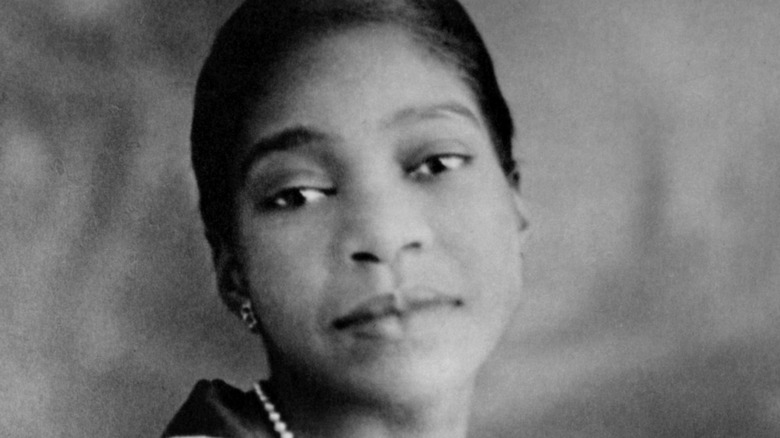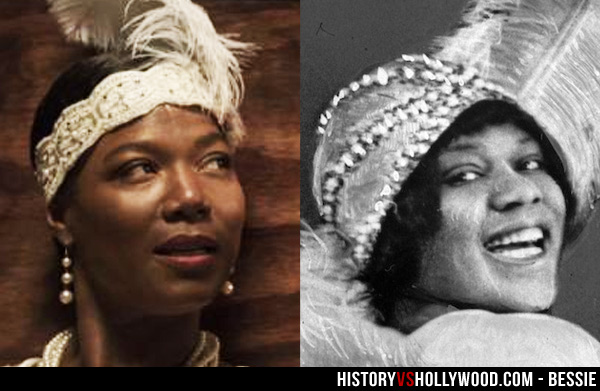Bessie Smith
Bessie Smith

Bessie Smith (April 15, 1894 – September 26, 1937) was an African-American blues singer widely renowned during the Jazz Age. Nicknamed the "Empress of the Blues," she was the most popular female blues singer of the 1930s. Inducted into the Rock and Roll Hall of Fame in 1989, she is often regarded as one of the greatest singers of her era and was a major influence on fellow blues singers, as well as jazz vocalists.
Born in Chattanooga, Tennessee, Bessie Smith was young when her parents died, and she and her six siblings survived by performing on street corners. She began touring and performed in a group that included Ma Rainey, and later embarked on her solo career. Her successful recording career with Columbia Records began in 1923, but her performing career was tragically cut short by a car crash that claimed her life at the age of 43.
The 1900 census indicates that her family reported that Bessie Smith was born in Chattanooga, Tennessee, in July 1892. The 1910 census gives her age as 16, and a birth date of April 15, 1894, which appears on subsequent documents and was observed as her birthday by the Smith family. The 1870 and 1880 censuses report several older siblings or half-siblings.
Smith was the daughter of Laura and William Smith, a laborer and part-time Baptist preacher. He died while his daughter was too young to remember him. By the time Bessie was nine, her mother and a brother had also died, and her older sister Viola took charge of caring for her siblings. As a consequence, Bessie was unable to gain an education.
Due to her parents' death and her poverty, Bessie experienced a "wretched childhood." To earn money for their impoverished household, Bessie and her brother Andrew busked on the streets of Chattanooga. She sang and danced as he played the guitar, often performing on "street corners for pennies," with their habitual location in front of the White Elephant Saloon at Thirteenth and Elm streets, in the heart of the city's African-American community.
In 1904, her oldest brother Clarence left home and joined a small traveling troupe owned by Moses Stokes. "If Bessie had been old enough, she would have gone with him," said Clarence's widow, Maud. "That's why he left without telling her, but Clarence told me she was ready, even then. Of course, she was only a child."
In 1912, Clarence returned to Chattanooga with the Stokes troupe and arranged an audition for his sister with the troupe managers, Lonnie and Cora Fisher. Bessie was hired as a dancer rather than a vocalist since the company already included popular singer Ma Rainey. Contemporary accounts indicate that, while Ma Rainey did not teach Smith to sing, she likely helped her develop a stage presence. Smith eventually moved on to performing in chorus lines, making the "81" Theatre in Atlanta her home base. She also performed in shows on the black-owned Theater Owners Booking Association (T.O.B.A.) circuit and would become one of its major attractions.
Bessie Smith began forming her own act around 1913 at Atlanta's "81" Theater. By 1920, she had established a reputation in the South and along the East Coast. At the time, the sales of over 100,000 copies of "Crazy Blues," recorded for Okeh Records by the singer Mamie Smith (no relation), pointed to a new market. The recording industry had not directed its product to black people, but the success of the record led to a search for female blues singers.
Hoping to capitalize on this new market, Bessie Smith began her recording career in 1923. She was signed to Columbia Records by Frank Walker, a talent agent who had seen her perform years earlier. Her first recording session for Columbia took place on February 15, 1923, and it was engineered by Dan Hornsby, who was recording and discovering many southern music talents of that era. For most of 1923, her records were issued on Columbia's regular A-series. When the company established a "race records" series, Smith's "Cemetery Blues" (September 26, 1923) was the first issued. Both sides of her first record, "Downhearted Blues" backed with "Gulf Coast Blues," were hits. (An earlier recording of "Downhearted Blues" by its co-writer Alberta Hunter had previously been released by Paramount Records.)
As her popularity increased, Bessie Smith became a headliner on the Theatre Owners Booking Association (T.O.B.A.) circuit and rose to become its top attraction in the 1920s. Working a heavy theater schedule during the winter and performing in tent shows the rest of the year, Smith became the highest-paid black entertainer of her day and began traveling in her own 72-foot-long railroad car. Columbia's publicity department nicknamed her "Queen of the Blues," but the national press soon upgraded her title to the "Empress of the Blues." Smith's music stressed independence, fearlessness, and sexual freedom, implicitly arguing that working-class women did not have to alter their behavior to be worthy of respect.
Despite her success, neither she nor her music was accepted in all circles. She once auditioned for Black Swan Records (W. E. B. Du Bois was on its board of directors) and was dismissed because she was considered too rough, as she supposedly stopped singing to spit. The businessmen involved with Black Swan Records were surprised when she became the most successful diva because her style was rougher and coarser than Mamie Smith. Even her admirers—white and black—considered her a "rough" woman (i.e., working class or even "low class").
Smith had a strong contralto voice, which recorded well from her first session, conducted when recordings were made acoustically. The advent of electrical recording made the power of her voice even more evident. Her first electrical recording was "Cake Walking Babies [From Home]," recorded on May 5, 1925. Smith also benefited from the new technology of radio broadcasting, even on stations in the segregated South. For example, after giving a concert to a white-only audience at a theater in Memphis, Tennessee, in October 1923, she performed a late-night concert on station WMC, which was well received by the radio audience. Musicians and composers like Danny Barker and Tommy Dorsey compared her presence and delivery to a preacher because of her ability to enrapture and move her audience.
Bessie Smith made 160 recordings for Columbia, often accompanied by the finest musicians of the day, notably Louis Armstrong, Coleman Hawkins, Fletcher Henderson, James P. Johnson, Joe Smith, and Charlie Green. A number of Smith's recordings, such as "Alexander's Ragtime Band" in 1927, quickly became among the best-selling records of their release years.
Bessie Smith's career was indeed affected by the Great Depression, which nearly put the recording industry out of business, and the advent of sound in film, leading to the decline of vaudeville. Despite these challenges, she never stopped performing. The days of elaborate vaudeville shows were over, but Smith continued touring and occasionally sang in clubs. In 1929, she appeared in a Broadway musical, "Pansy." The play was a flop, with top critics noting that she was its only asset.
In November 1929, Bessie Smith made her only film appearance, starring in a two-reeler titled "St. Louis Blues," based on composer W. C. Handy's song of the same name. Directed by Dudley Murphy and shot in Astoria, Queens, she sings the title song accompanied by members of Fletcher Henderson's orchestra, the Hall Johnson Choir, the pianist James P. Johnson, and a string section. This musical environment was radically different from that of any of her recordings.
In 1933, John Henry Hammond, who also mentored Billie Holiday, asked Bessie Smith to record four sides for Okeh (which had been acquired by Columbia Records in 1925). He claimed to have found her in semi-obscurity, stating she was "working as a hostess in a speakeasy on Ridge Avenue in Philadelphia." However, Smith worked at Art's Cafe on Ridge Avenue, but not as a hostess, and not until the summer of 1936. In 1933, when she made the Okeh sides, she was still touring. Hammond was known for his selective memory and gratuitous embellishments.
On September 26, 1937, Smith was critically injured in a car crash on U.S. Route 61 between Memphis, Tennessee, and Clarksdale, Mississippi.[8] Her lover, Richard Morgan, was driving, and misjudged the speed of a slow-moving truck ahead of him. Skid marks at the scene suggested that Morgan tried to avoid the truck by driving around its left side, but he hit the rear of the truck side-on at high speed. The tailgate of the truck sheared off the wooden roof of Smith's old Packard vehicle. Smith, who was in the passenger seat, probably with her right arm or elbow out the window, took the full brunt of the impact. Morgan escaped without injuries.
The first person on the scene was a Memphis surgeon, Dr. Hugh Smith (no relation). In the early 1970s, Hugh Smith gave a detailed account of his experience to Bessie's biographer Chris Albertson. This is the most reliable eyewitness testimony about the events surrounding her death.
Arriving at the scene, Dr. Smith examined Smith, who was lying in the middle of the road with obviously severe injuries. He estimated she had lost about a half pint of blood, and immediately noted a major traumatic injury: her right arm was almost completely severed at the elbow.[26] He stated that this injury alone did not cause her death. Though the light was poor, he observed only minor head injuries. He attributed her death to extensive and severe crush injuries to the entire right side of her body, consistent with a sideswipe collision.
Henry Broughton, a fishing partner of Dr. Smith's, helped him move Smith to the shoulder of the road. Dr. Smith dressed her arm injury with a clean handkerchief and asked Broughton to go to a house about 500 feet off the road to call an ambulance. By the time Broughton returned, about 25 minutes later, Smith was in shock.
Time passed with no sign of the ambulance, so Dr. Smith suggested that they take her into Clarksdale in his car. He and Broughton had almost finished clearing the back seat when they heard the sound of a car approaching at high speed. Dr. Smith flashed his lights in warning, but the oncoming car failed to slow and plowed into his car at full speed. It sent his car careening into Smith's overturned Packard, completely wrecking it. The oncoming car ricocheted off Hugh Smith's car into the ditch on the right, barely missing Broughton and Bessie Smith.
"The Bessie Smith ambulance would not have gone to a white hospital; you can forget that", Hugh Smith told Albertson. "Down in the Deep South Cotton Belt, no ambulance driver, or white driver, would even have thought of putting a colored person off in a hospital for white folks."
References
- "Bessie Smith: Controversy". SparkNotes. October 4, 1937. Retrieved August 30, 2015.
- ^ Eagle, Bob; LeBlanc, Eric S. (2013). Blues: A Regional Experience. Santa Barbara, California: Praeger. p. 50. ISBN 978-0313344237.
- ^ Scott, Michelle R. (2010). Blues Empress in Black culture: Bessie Smith and the Emerging Urban South. Champaign, Illinois: University of Illinois Press. p. 152. ISBN 9780252092374.
- ^ 1900 US census, Hamilton, Tennessee, Schedule 1, Chattanooga Ward 04, District 0060, p.23.
- ^ 1910 US Census, Chattanooga, Hamilton, Tennessee, Ward 7, Enumeration District 0065, Sheet 2B, Family No. 48.^ Jump up to:
- a b c Albertson, Chris (2003). Bessie. New Haven: [Yale University Press]. ISBN 0-300-09902-9.
- ^ Jasen, David A.; Jones, Gene (September 1998). Spreadin' Rhythm Around: Black Popular Songwriters, 1880–1930. New York City: Schirmer Books. p. 289. ISBN 978-0-02-864742-5.^ Jump up to:
- a b c d e f g h Moore, Carman (March 9, 1969). "Blues and Bessie Smith". The New York Times. pp. 262, 270. Retrieved April 27, 2020.
- ^ Albertson, 2003, p. 11.
- ^ Albertson, 2003, pp. 14–15.



































